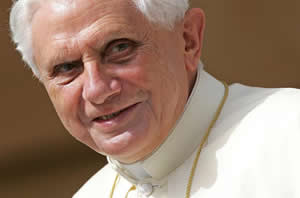Obedience, Easter, Jesus and women
 On the Radicalism of Obedience
On the Radicalism of Obedience
Pope Benedict concluded, “we must also pay attention to the content of Jesus’ prayer on the Mount of Olives. Jesus says: “Father, for you all things are possible; remove this cup from me; yet not what I want, but what you want”.
The natural will of the man Jesus recoils in fear before the enormity of the matter. He asks to be spared. Yet as the Son, He places this human will into the Father’s will: not I, but you. In this way He transformed the stance of Adam, the primordial human sin, and thus heals humanity. The stance of Adam was: not what you, O God, have desired; rather, I myself want to be a god. ... This is the fundamental rebellion present throughout history and the fundamental lie which perverts life.
When human beings set themselves against God, they set themselves against the truth of their own being and consequently do not become free, but alienated from themselves. We are free only if we stand in the truth of our being, if we are united to God. Then we become truly “like God” - not by resisting God, eliminating Him, or denying Him.
In His anguished prayer on the Mount of Olives, Jesus resolved the false opposition between obedience and freedom, and opened the path to freedom”.
On Easter, the New Creation
“Easter is the feast of the new creation. Jesus is risen and dies no more. He has opened the door to a new life, one that no longer knows illness and death. He has taken mankind up into God Himself. ... Creation has become greater and broader. Easter Day ushers in a new creation, but that is precisely why the Church starts the liturgy on this day with the old creation, so that we can learn to understand the new one aright. ... Two things are particularly important here in connection with this liturgy.
On the one hand, creation is presented as a whole that includes the phenomenon of time. The seven days are an image of completeness, unfolding in time. They are ordered towards the seventh day, the day of the freedom of all creatures for God and for one another. Creation is therefore directed towards the coming together of God and His creatures; it exists so as to open up a space for the response to God’s great glory, an encounter between love and freedom.
On the other hand, what the Church hears on Easter night is above all the first element of the creation account: “God said, ‘let there be light!’””.
“At Easter, on the morning of the first day of the week, God said once again: “Let there be light”. The night on the Mount of Olives, the solar eclipse of Jesus’ passion and death, the night of the grave had all passed. Now it is the first day once again - creation is beginning anew. ... Jesus rises from the grave. Life is stronger than death. Good is stronger than evil. ... But this applies not only to Him, not only to the darkness of those days. With the resurrection of Jesus, light itself is created anew. He draws all of us after Him into the new light of the resurrection and he conquers all darkness”.
On the special bond of Jesus with Women
“The moment of the resurrection per se is not described by the Evangelists. It remains a mystery, not in the sense that it is less real, but that it is hidden, beyond the scope of our understanding, like a light so bright that we cannot look at it without our eyes being blinded. The narratives begin when, at dawn on the day after the Saturday, the women went to the tomb and found it open and empty. ... Having received the announcement of the resurrection from the Angel they ran, full of fear and joy, to give the news to the disciples. At that very moment they met Jesus, bowing before His feet and worshipping Him as He said: ‘Do not be afraid, go and tell my brothers to go to Galilee; there they will see me’.
“All the Gospels dedicate a lot of space to the women in the narratives of the apparitions of the Risen Jesus, just as they do in those of His passion and death. In Israel at that time the testimony of women did not have official juridical weight, but women experienced a special bond with the Lord and this is fundamental for the real life of the Christian community, in all times and ages, not just in the early days of the Church”.
The Pope concluded by recalling that the model for this relationship with Jesus, especially in the Easter mystery, is Mary, Mother of the Lord. “Through the transforming experience of her Son’s passion, the Virgin Mary also became Mother of the Church; that is, of each believer and of the entire community”
Tagged as: Easter, obedience, Pope Benedict, women
Comments are closed.
 Entries(RSS)
Entries(RSS)